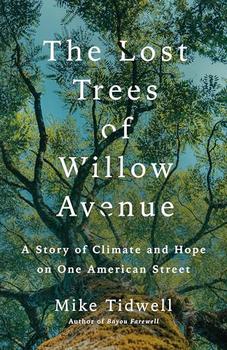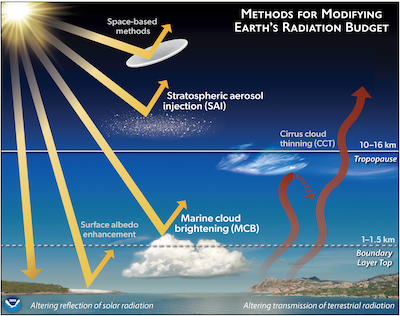Summary | Excerpt | Reviews | Beyond the Book | Read-Alikes | Genres & Themes | Author Bio

A Story of Climate and Hope on One American Street
by Mike TidwellThis article relates to The Lost Trees of Willow Avenue
In The Lost Trees of Willow Avenue, author Mike Tidwell offers an overview of strategies being researched and implemented to mitigate climate change. Overall, the main strategies are decarbonization and the drastic cutting of greenhouse gas emissions by switching from fossil fuels to renewable energy. Geoengineering technologies also aim to reverse the effects of climate change and remove carbon dioxide from the atmosphere. Here's a brief summary of a few specific approaches with the potential to slow the effects of climate change:
Solar Radiation Modification

Solar radiation modification involves reflecting sunlight back into the atmosphere before it can reach the Earth and raise surface temperatures. This technology is modeled on the 1991 eruption of Mt. Pinatubo in the Philippines, whose sulfur emissions led to half a degree of cooling worldwide. Stratospheric aerosol injection mimics a volcanic eruption by releasing particulates or their precursors, such as sulfur dioxide, into the stratosphere (the second-lowest layer of the atmosphere). Marine cloud brightening (MCB) involves injecting aerosols such as sea salt into the lower atmosphere to increase the reflectivity of clouds over oceans. In the book, Tidwell meets a NASA scientist, Dr. Tianle Yuan, who is working on MCB. Other strategies include surface albedo enhancement (white roofs), cirrus cloud thinning, and the installation of giant mirrors in space to reflect sunlight before it enters the Earth's atmosphere.
Carbon Sequestration
In Tidwell's book, Ning Zeng's project of burying dead trees serves as a method of carbon sequestration. Trees are natural carbon sinks in that they absorb more carbon dioxide than they release. Wood vaults such as Zeng's form part of a broader umbrella of strategies for carbon dioxide removal (also including peatland restoration and reforestation). These strategies shift the goal from the reduction of emissions to the achievement of "negative emissions."
Regenerative Agriculture
Regenerative agriculture—as opposed to the business-as-usual practice of industrial agriculture—aims to restore soil health and improve biodiversity. This farming approach minimizes soil disturbance (the "no-till" practice reduces erosion, compaction, and the loss of soil moisture) and the use of artificial fertilizers or pesticides. It also involves rotating crops, and using cover crops during fallow periods, to maintain the soil's fertility and keep weeds and plant diseases under control. Soil can also be enhanced with biochar (a form of charcoal made by heating plant matter without oxygen) or a crushed silicate rock such as basalt.
Although it is encouraging that so many avenues are being explored, often the political will to fund scientific research does not exist. As citizens, we can get involved in small-scale community projects, but it is also important to pressure politicians into cooperating on global initiatives with broader effects.
Proposed methods for modifying Earth's radiation budget, including SRM methods and cirrus cloud thinning, courtesy of climate.gov
Filed under Nature and the Environment
![]() This article relates to The Lost Trees of Willow Avenue.
It first ran in the April 9, 2025
issue of BookBrowse Recommends.
This article relates to The Lost Trees of Willow Avenue.
It first ran in the April 9, 2025
issue of BookBrowse Recommends.
Don't join the book burners. Don't think you are going to conceal faults by concealing evidence that they ever ...
Click Here to find out who said this, as well as discovering other famous literary quotes!
Your guide toexceptional books
BookBrowse seeks out and recommends the best in contemporary fiction and nonfiction—books that not only engage and entertain but also deepen our understanding of ourselves and the world around us.